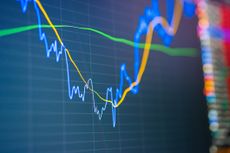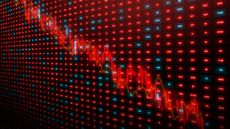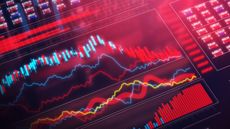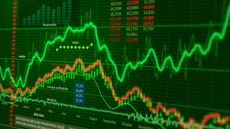10 Stocks for the Next 10 Years
You can rest easy knowing these companies will deliver consistent returns over the long haul.
When it comes to stocks, big isn't always better. But if you choose well, big companies are more likely than small ones to deliver consistent returns over the long haul. And they're far more likely to withstand the economic, political and technological shocks that can derail small companies.
Big-company stocks have hardly been immunized from the market's current turmoil. As of October 27, Standard & Poor's 500-stock index is down 46% from its record high, set on October 9, 2007. But lower prices today makes it more likely that stocks will match its historical long-term return of 10% year.
We here at Kiplinger's Personal Finance put our heads together in search of ten giants (which we defined as companies with a market value of at least $10 billion) that we think can better the market's long-term results over the next decade. We came up with an eclectic list that contains a number of names you'd expect to see and some that may surprise you. Below are our ten picks for the next ten years.

Sign up for Kiplinger’s Free E-Newsletters
Profit and prosper with the best of expert advice on investing, taxes, retirement, personal finance and more - straight to your e-mail.
Profit and prosper with the best of expert advice - straight to your e-mail.
| Row 0 - Cell 0 | The One Stock They Would Buy |
| Row 1 - Cell 0 | The Best Mutual Funds |
| Row 2 - Cell 0 | The Best ETFs |
PROCTER & GAMBLE (PG). If you're a Procter & Gamble shareholder, it must feel nice to go to bed knowing that hundreds of millions of consumers around the world will use Gillette razors, Crest toothpaste and Head & Shoulders shampoo the next morning. People need to shave, bathe and brush their teeth in any economy, and P&G's brands are so powerful that it can pass on price increases in raw materials to its loyal customers.
This consistency has allowed P&G to compound earnings by 10% a year over the past ten years; Wall Street projects a like result over at least the next five years. Factor in a 3% yield and a rising dividend stream and it equals an attractive ten-year holding.
ELECTRONIC ARTS (symbol ERTS). Spore, the latest game from Electronic Arts, is a metaphor for the company itself. In the game, a single-celled organism evolves by eating other animals and eventually masters the universe. Electronic Arts has grown mainly by acquisition to become the biggest video-game software company; sales for the fiscal year that ends next March should top $5 billion.
Electronic Arts dominates a rapidly expanding universe. Sales from consoles and software together hit $18.8 billion in 2007, a 43% increase from 2006, says the NPD Group. Not even the torpid economy is likely to dent the industry's -- or EA's-rapid growth. Analysts see the company's earnings rising 21% annually over the next three to five years.
FIRST SOLAR (FSLR). As the price of oil has retreated, investors have lost interest in alternative-energy stocks. But once global economies right themselves, demand for oil will rise and so will its price. The need for cheaper and cleaner fuel sources will once again become plain, and alternative-energy stocks will revive. One of the biggest beneficiaries is sure to be First Solar. Based in Tempe, Ariz., First Solar produces solar modules using a proprietary thin-film semiconductor technology that uses far less silicon than other production processes. The company sells the majority of its modules in Germany, which subsidizes solar energy, but First Solar has deals with utilities to build photovoltaic generating plants in California, Florida and Nevada.
Its growth has been breathtaking. In 2006, when First Solar went public, it earned 7 cents a share on $135 million in revenues. In 2008, analysts estimate, the company will earn $3.67 per share on sales of $1.2 billion. And analysts see earnings growing 56% annually over the next few years. The stock, which is up six-fold from the IPO, is risky, but it will deliver big rewards as long as oil prices recover and governments continue to subsidize solar power.
GILEAD SCIENCES (GILD). Gilead Sciences has built a formidable franchise in drugs that treat HIV. They provide about 75% of the firm's revenue, which is expected to exceed $5 billion this year. Those drugs should provide the Foster City, Cal.-based biotech company with robust growth in the coming decade, even as it diversifies into other promising areas, such as medicines that treat hepatitis, hypertension and influenza. Gilead's portfolio of drugs faces little threat from generics, and the company can use its ample cash reserves ($3 billion as of midyear) to supplement its development pipeline via acquisitions and partnerships.
GOOGLE (GOOG). Google is the single most visited Web site in the U.S., a cultural phenomenon and a verb. And in just four years as a publicly traded company, it has achieved the status of Internet behemoth, with a market value in the neighborhood of $105 billion.
But as a business Google is an advertising firm; pay-per-click search-engine advertising represents 90% of revenues, and all advertising taken together brings in 97%. Enormous profits over the past five years have endowed Google with the cash to pursue such lofty goals as projecting interactive satellite images of the cosmos onto your computer screen and digitizing all books ever written.
Yet Google's strength in its basic ad business is reason enough to love it. As more ad dollars shift from old media to new media, Google's scale and formidable brain trust give it the strength to remain the market leader. And despite the company's immensity, analysts expect earnings to grow at a hefty 22% annual pace over the next few years. Ten years? Sure.
[page break]
MONSANTO (MON). Monsanto has emerged as one of the great growth stocks of this decade, returning an annualized 44% over the past five years. The world is hungry for grain, meat and ethanol. Monsanto's high-tech seeds, genomics and herbicides boost the productivity of corn, soybean, cotton and wheat farms. Monsanto's seed technology is years ahead of competitors', and its market penetration is expanding worldwide, to cropland in places such as Brazil and Argentina.
Yes, it has its critics, who complain of Monsanto's business practices. But earnings have compounded by 41% annually over the past five years. Wall Street thinks this rate of profit growth will exceed 30% annualized over the next three to five years. Its 10-year horizon looks bright.
NORFOLK SOUTHERN (NSC). North American railroads are sitting in the sweet spot -- you'd hardly know a recession set in, and they can raise prices freely for the first time in many decades. Norfolk Southern occupies the sweetest spot of them all. Its forward-looking management has initiatives under way to greatly increase capacity and gain new customers -- particularly truckers operating between the Northeast and the South and between the mid-Atlantic ports and the Midwest.
Balancing Norfolk Southern's many partnerships with truckers is its thriving business hauling coal to power plants and to ships at the ports. And the company's network of routes that honeycomb the U.S. east of the Mississippi is run more efficiently than that of chief rival CSX. Put it all together, and it's hard to see how a long-term investment in this railroad could go wrong
T. ROWE PRICE (TROW). The stock market's awful performance this year has shaken the faith of the investor class. But once the bear market ends and investors regain confidence in capitalism, they’re likely to resume saving like mad for retirements that look less and less secure. Fund manager T. Rowe Price, with some $345 billion in assets at last report, should benefit enormously from this trend. Its target-date retirement funds are already big hits with investors. By preaching a conservative, long-term investment approach and keeping costs low, Price has delivered above-average results at a majority of its funds. And the company has avoided scandals.
Asset management is a lucrative business -- Price's net profit margins are about 30%. The company has no debt and has raised its dividend every year since going public in 1986. Earnings Earnings are likely to be down in both 2008 and 2009 because of the weak stock market, which holds down asset growth. But analysts see profits growing 15% a year long term.
SCHLUMBERGER (SLB). Schlumberger is the ultimate global growth company. . The world is desperate to renew depleted oil and gas reserves and find new sources, so producers are spending frenetically to discover oil and gas both on land and beneath the seas. This requires the wide technology of Schlumberger, the world's biggest provider of energy exploration and engineering services. Chief executive Andrew Gould says the big hunt for new sources—and work to extend the lives of known fields in the U.S., the North Sea and the Middle East—will go on for years, regardless of price fluctuations for oil and gas. Schlumberger shares have taken gas as oil prices and the stock market in general have cratered, but this is a case of the herd dumping anything it can sell.
Despite the Houston-based company's immensity (revenues should approach $28 billion this year), analysts expect earnings growth of 12% annually over the next few years.
VISA (V). Many companies are poised to benefit from globalization, but few do so as directly as Visa. After all, your Visa card is good everywhere from the supermarket down the street to a mom-and-pop shop in Nepal. When Visa went public in March 2008, it raised $17.9 billion, making it the largest initial public offering in U.S. history. The stock's market value now exceeds $50 billion.
Visa has the world's largest payment network, in which banks and businesses are eager to participate. And because Visa just processes payments, rather than act as a lender in transactions, it's nicely insulated from the credit crunch. Paperless payments are projected to surge from a bit more than 40% now to 70% of total payments in 2010. Visa is riding the crest of that wave.
By Manuel Schiffres, Andrew Tanzer, Bob Frick, David Landis, Elizabeth OdyFred Frailey,
and Jeff Kosnett
-
 Stock Market Today: S&P 500, Nasdaq Extend Losing Streaks
Stock Market Today: S&P 500, Nasdaq Extend Losing StreaksThe two indexes have closed lower for five straight sessions.
By Karee Venema Published
-
 Save Over $40 on Audible With Amazon's Latest Deal
Save Over $40 on Audible With Amazon's Latest DealAmazon’s latest promotion lets you score three months of Audible for just $0.99 a month.
By Erin Bendig Published
-
 Stock Market Today: S&P 500, Nasdaq Extend Losing Streaks
Stock Market Today: S&P 500, Nasdaq Extend Losing StreaksThe two indexes have closed lower for five straight sessions.
By Karee Venema Published
-
 Stock Market Today: Dow Slips After Travelers' Earnings Miss
Stock Market Today: Dow Slips After Travelers' Earnings MissThe property and casualty insurer posted a bottom-line miss as catastrophe losses spiked.
By Karee Venema Published
-
 Stock Market Today: Stocks Stabilize After Powell's Rate-Cut Warning
Stock Market Today: Stocks Stabilize After Powell's Rate-Cut WarningThe main indexes temporarily tumbled after Fed Chair Powell said interest rates could stay higher for longer.
By Karee Venema Published
-
 Stock Market Today: Stocks Reverse Lower as Treasury Yields Spike
Stock Market Today: Stocks Reverse Lower as Treasury Yields SpikeA good-news-is-bad-news retail sales report lowered rate-cut expectations and caused government bond yields to surge.
By Karee Venema Last updated
-
 Stock Market Today: Nasdaq Leads as Magnificent 7 Stocks Rise
Stock Market Today: Nasdaq Leads as Magnificent 7 Stocks RiseStrength in several mega-cap tech and communication services stocks kept the main indexes higher Thursday.
By Karee Venema Published
-
 Stock Market Today: Stocks Tumble After a Hot Inflation Print
Stock Market Today: Stocks Tumble After a Hot Inflation PrintEquities retreated after inflation data called the Fed's rate-cut plans into question.
By Dan Burrows Published
-
 Stock Market Today: Stocks End Mixed Ahead of Key Inflation Reading
Stock Market Today: Stocks End Mixed Ahead of Key Inflation ReadingEquities struggled before tomorrow's big Consumer Price Index report.
By Dan Burrows Published
-
 Stock Market Today: Stocks Closed Mixed in Choppy Trading
Stock Market Today: Stocks Closed Mixed in Choppy TradingVolatility returned as market participants adjusted their expectations for rate cuts.
By Dan Burrows Published